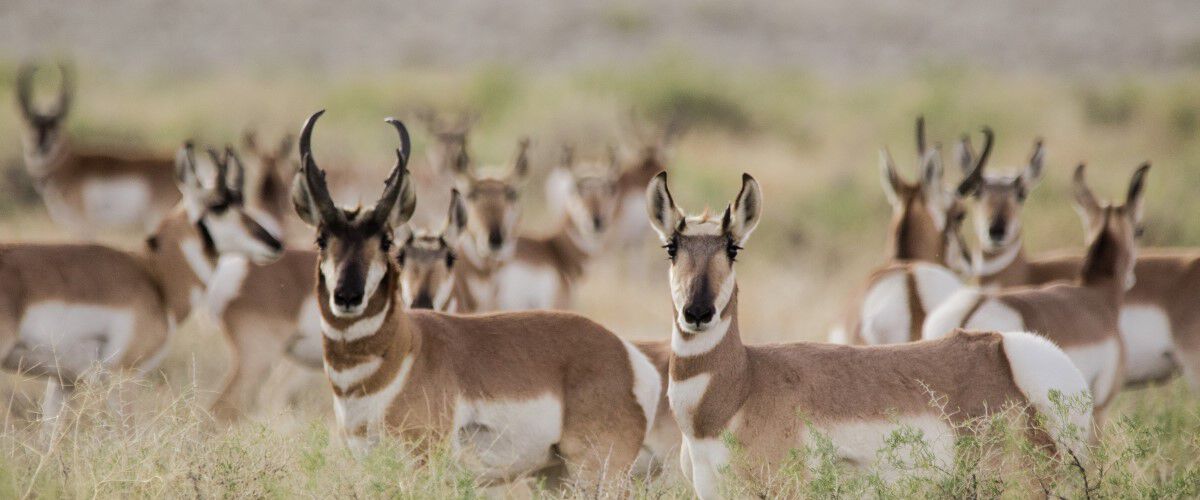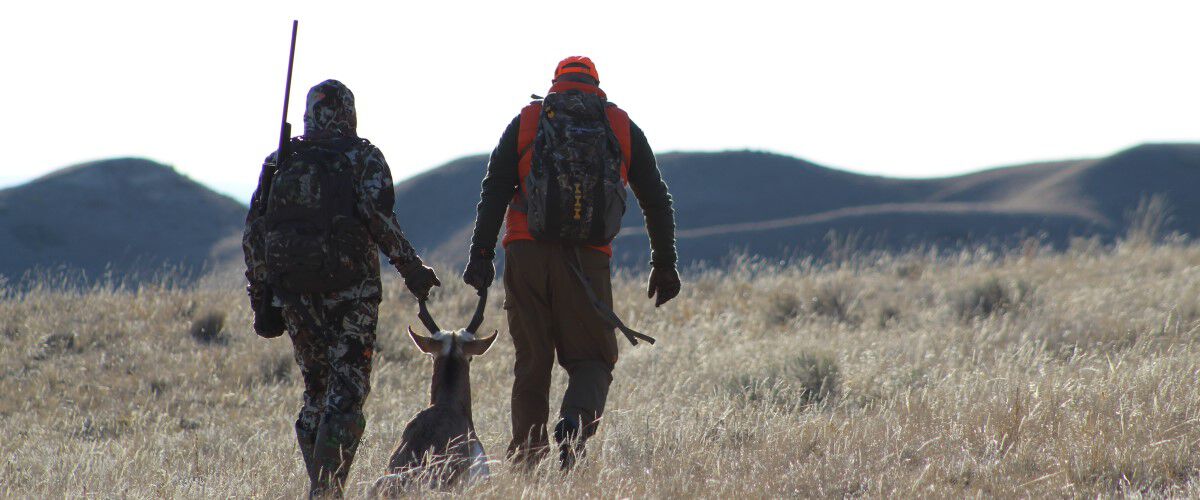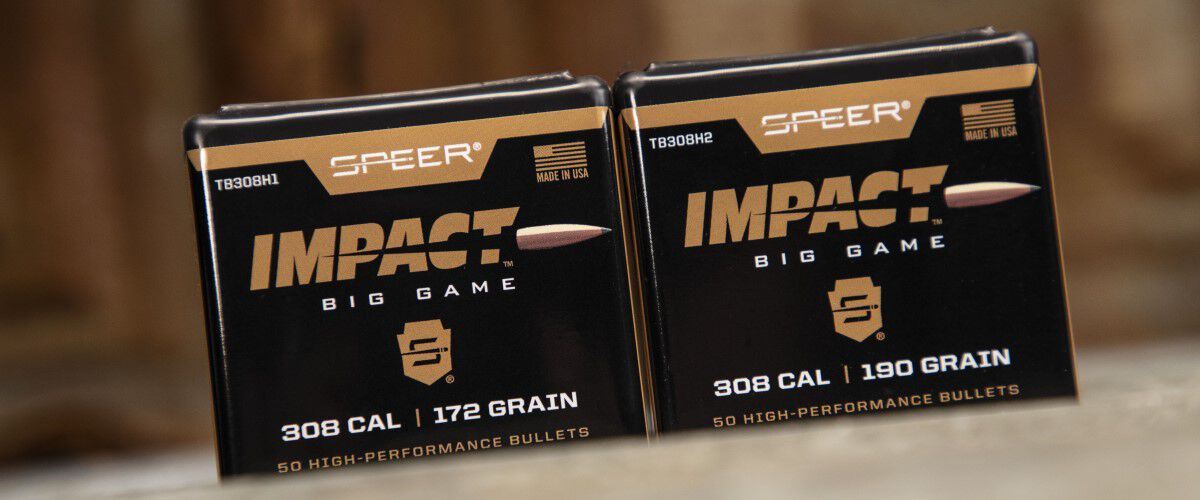
I carefully eased my way to a Wyoming ridge to find a herd of about 30 pronghorn I’d spotted earlier running across a sage flat. They didn’t seem spooked as they ran but simply wanted to put their impressive speed to use, buzzing across the open flat in search of a grazing spot that placed them out of the wind. If my estimates were correct, the animals would be between 200 and 400 yards away, which would make for an easy shot on the large buck I’d seen trailing the group.
When I crested the hill, the antelope were closer to 400 yards away, but it was of little consequence. I’d skylined myself just enough to draw their attention and this time when they ran, they meant to make good their escape, displaying their signature speed as they disappeared behind a cloud of white dust. I’d learned my lesson: never underestimate a pronghorn’s eyes.
That trip introduced me to antelope hunting, and since then chasing pronghorn across the open prairies has become one of my favorite pursuits. And, thankfully, as the price of guided hunts climb and point creep makes it more difficult to draw prime tags for elk, mule deer and sheep, pronghorn hunts have remained relatively affordable. Whether you’re planning your first western hunt or your fifteenth, pronghorn hunting never disappoints.
The Strange History
American antelope are the sole surviving member of the family Antilocapridae. Fossil records show there were, at various periods in history, at least 10 other members of this family roaming the expanses of North America and that as many as four of these family members survived until the first humans crossed the Bering Strait. Today, however, the pronghorn, Antilocapra americana, is the sole survivor of this unique animal family.
Though it’s commonly called an antelope (the name most likely given to the species by Lewis and Clark in their journals), Antilocapra americana is most closely related to giraffes and the African okapi. It also happens to be the fastest land animal in the Western Hemisphere. Clocked at speeds topping 60 miles per hour, the pronghorn is substantially faster than the fastest land predator in America, the coyote, which can reach speeds of up to 40 miles per hour.
But why would the pronghorn evolve such astounding speed? During the course of ordinary evolution, no prey species develops speed that so substantially outpaces its swiftest predator. The working theory for years has been that the pronghorn was a principal target of the now extinct North American cheetah, though that theory has come into question in recent years.

What we do know is that the pronghorn was born to run. Species that rely on great speed like the cheetah and peregrine falcon also tend to have advanced vision, and the pronghorn is no exception. Unlike deer and elk which rely more on their sense of smell than their eyes, pronghorns use their astounding vision to locate and evade prey. When they do decide to run, antelope can cover many miles at a fast clip.
Opportunities For Pronghorn
Though the species was once hunted nearly to extinction, the pronghorn population has rebounded and there are currently somewhere in the neighborhood of one million antelope across the western United States. These animals thrive on dry, open plains from Canada to Sonora, Mexico, but the best overall state for pronghorn hunting is Wyoming. It’s said pronghorns outnumber people there, and that equates to opportunities for good bucks and low-cost hunts. Colorado, Montana, California and Utah also offer good opportunities at pronghorn, as do Nevada and Idaho in if you can draw a tag in the best units.
If shooting a really big antelope is your mission, though, set your sights on the high deserts of Arizona and New Mexico. These two states dominate the record books, and they still offer the best bet to harvest a giant pronghorn, although states like Wyoming aren’t far behind and most novice hunters won’t be able to tell the difference between an 80-inch Wyoming goat and a 90-inch New Mexico one. When you’re new to the sport and you’ve been staring at antelope for days any mature buck looks good.
If you’re booking a fully-guided pronghorn hunt, plan on spending $2,000 to $4,500 per person, depending upon the area you’re hunting and the quality of the game. Some hunters prefer to pay a trespass fee and hunt on private ranchland, and where that’s allowed you can oftentimes obtain rights to hunt for a short period for a grand or less. Of course, you can always plan a DIY hunt, which is not difficult with antelope.
The Gear
Antelope aren’t large animals: Big bucks weigh up to 140 pounds, and the average mature pronghorn tips the scales between 100 and 120 pounds. Your 6mm, .257, 6.5 mm, .270 or 7mm deer rifle will work fine, and there are even hunters who pursue antelope with fast .22 centerfires where legal. But you need an accurate rifle and a good optic. For optics, I prefer something in the 3-15x range, and if you want to hike for your antelope the lighter the optic the better.
High-quality hunting bullets are extremely important because shots are often long and the target is relatively small, which requires pinpoint accuracy. Speer’s Impact bullet’s aerodynamic design and resulting high ballistic coefficients make it ideal for a pronghorn hunting. The Slipstream polymer tip further improves BC while initiating expansion at velocities 200 feet-per-second lower than competing bullets. It’s molecularly bonded for durability but unlike bullets designed for large, heavy-boned game it will still expand properly to maximize shock for clean, quick kills. The new 6.5mm version will make the 6.5

In addition to a good scope you’ll also need very good binoculars and a spotting scope. Judging an inch or two of horn at great distances through mirage requires very good glass.
Since pronghorn seasons open as early as late summer in many parts of the country I think lightweight, breathable cotton clothing that dries quickly is a must. This can always serve as a base layer should the temperature drop, which happens quickly when the sun sets on the arid high plains. Good boots and head cover are important, and I hunt pronghorn in sunglasses to cut glare. Knee pads and gloves are also important because you’ll need to stay low to remain out of sight and may have to crawl over rough ground.
Closing The Deal
There’s a rumor that pronghorn meat isn’t good to eat, but I’ve never found that to be true. I blame two things for the bad rap. First, most pronghorn hunts occur during warm weather and an animal that’s killed on a hot day needs to be immediately skinned to cool. Second, many hunters don’t properly handle the meat. If sage, dirt, and other contaminants get on it, it’s not surprising that it will taste bad when cooked. Take the time to get your buck butchered cleanly and on ice quickly, and you’ll love every bite.
Pronghorn are loads of fun to hunt, and if you have a deer rifle that shoots well at long range, you probably already have all you need. We all dream about hunting big game in the West, but for many people there’s not much hope of drawing a bighorn tag. What you can do, however, is chase antelope across the open plains. And I assure you it’s an adventure you’ll enjoy.